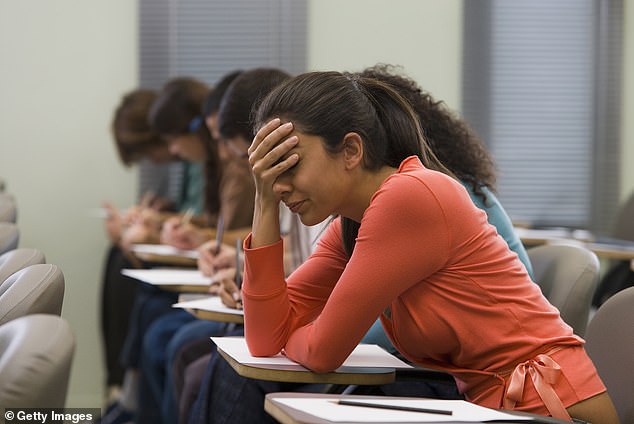Shock data shows that the number of PTSD diagnoses among students has doubled in five years
Data shows that the number of PTSD diagnoses – traditionally associated with war veterans – among college students has more than doubled in just five years.
Researchers found that 7.5 percent of students said they had post-traumatic stress disorder (PTSD) in 2022, the last year available, up from 3.4 percent in 2017.
Most of the increase was recorded during the Covid pandemic – when campuses were closed and many young people were asked to stay home or wear flimsy masks in class.
The graph above shows how PTSD diagnoses have increased since 2017
The researchers from the University of Alabama at Birmingham said some of the increase can be attributed to the relaxing of the condition’s definition in 2013.
But they have also suggested that ‘broader societal stressors’, such as school shootings and social media, could be to blame.
This has prompted warnings from some quarters about the ‘over-medicalisation’ of the younger generation – suggesting this revival is similar to the story told for other conditions such as anxiety.
PTSD is defined as a mental health condition caused by experiencing or witnessing a traumatic event that causes patients to suffer from persistent and disturbing thoughts.
However, in 2013, the definition was expanded to include dysphoria, or a deep sense of unease, and a negative worldview, which can be confused with depression.
It is not diagnosed by a single test, but patients instead undergo a mental assessment with a doctor before a diagnosis is made.
The increase was revealed in a research letter published in the journal JAMA network opened.

A study shows that the rate of PTSD among young people is rising (stock image)
For the study, scientists analyzed data from more than 390,000 students, including 18,000 who reported a PTSD diagnosis.
Data comes from the Healthy Minds Study, an annual web-based survey from the University of Michigan aimed at monitoring mental health in the US.
It was then analyzed to estimate the prevalence of PTSD among students – or the proportion of the group diagnosed with the condition – with the results also adjusting for factors such as gender, economic status and education level.
The results also showed a rise in levels of a similar condition, acute stress disorder, which rose from 0.2 to 0.7 percent of young people.
“The magnitude of the increase is indeed shocking,” the paper’s lead author and consultant, Yusen Shai, told the newspaper. New York Times.
Dr. Shannon Cusack, a psychologist in Virginia, added that there was division in the field over whether patients suffering from anxiety due to the Covid pandemic should be classified as having PTSD.
“They cause symptoms consistent with the PTSD diagnosis,” Dr. Cusack said.
“Am I not going to treat them because their stressor doesn’t count as trauma?”
Estimates suggest that five percent of adults in the US suffer from PTSD linked to a stressful event. Seven percent of veterans are diagnosed during their career.
